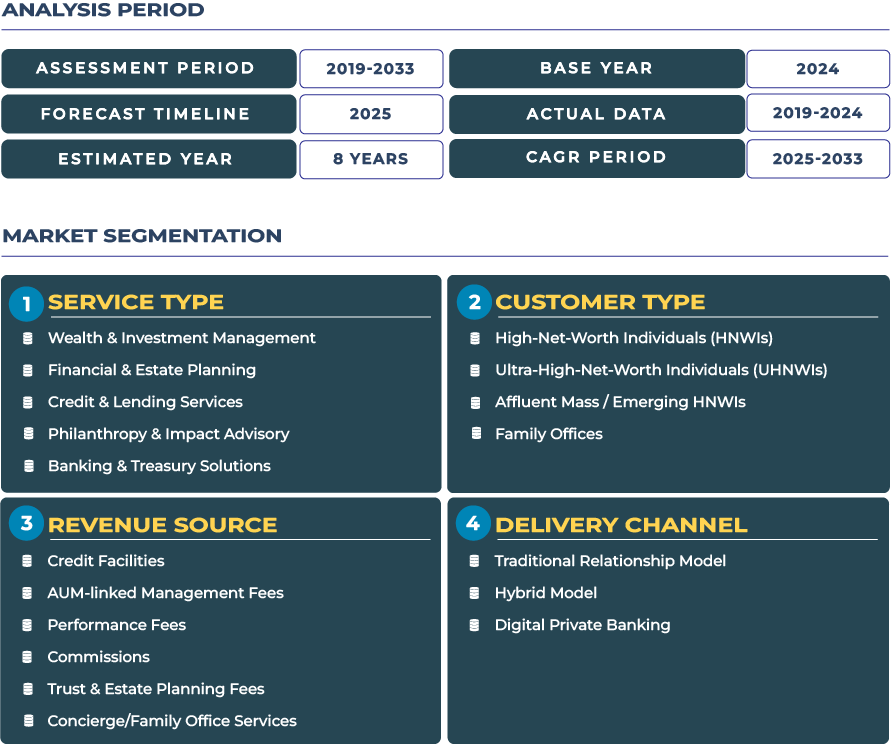Market Outlook: Mapping the Next Growth Curve in Europe’s Private Banking Sector
The outlook for the Europe private banking market presents a mélange of steady institution-led growth and structural renewal. With size expected to increase from USD 285.8 billion in 2025 to USD 378.4 billion by 2033, growing at a CAGR of 3.6%, the path forward is not about headline expansion but about deepening relevance. Wealth accumulation across high-net-worth individuals (HNWIs) and ultra-HNWIs (UHNWIs), the maturation of affluent digital behaviour and the shift toward integrated liquidity, investment and treasury services are all catalysts. However, achieving this growth requires private banks to re-engineer their value proposition: connecting bespoke lending, payments, investment services, insurance/bancassurance and treasury flows into a single cohesive platform.
Note:* The market size refers to the total revenue generated by banks through various services.
Macroeconomic and geopolitical realities shape this outlook decisively. Inflation-led interest-rate rises across the euro-area and UK compress margins, while the ongoing Ukraine war and energy-security concerns expose affluent clients to increased risk-aversion and demand for diversification. The pandemic catalysed digital acceleration, yet also raised expectations for remote advisory, liquidity agility and cross-jurisdiction access. In this context, European private banks that focus on operational efficiency, digital-first experience, alternative-investment access and cross-border advisory will be able to capture the modest yet resilient 3.6% CAGR. The narrative for growth is no longer simply “grow” - it is “transform and deepen.”
Drivers & Restraints: Core Catalysts and Barriers in Europe’s Private Banking Arena
Growth drivers. The European private banking sector is underpinned by several robust drivers. First, the continued accumulation of wealth among HNWIs and UHNWIs in mature markets-especially in the UK, Germany, Switzerland and France-is creating a larger addressable market for affluent-focused services. Second, the shift toward digital wealth engagement is enabling faster onboarding, richer client data insights and integrated services that span investment, payments, credit and treasury. Third, regulatory pressure and transparency demands (such as automatic exchange of information, tougher anti-money-laundering frameworks) are pushing clients toward established institutional providers with global reach-benefitting well-positioned private banks.
Growth restraints. Yet the landscape is not without headwinds. Profit-pool compression has been a decade-long challenge: European private banks have seen revenue-margin erosion, higher cost-income ratios and limited net-new-money growth in some markets. Economic volatility-such as inflation and interest-rate shocks-can suppress advisory demand and reduce asset-flow momentum. Geopolitical risks and regional fragmentation (Brexit, regulatory divergence across EU, sanctions regimes) complicate cross-border wealth flows and increase structural cost. Emerging digital wealth players and neo-banks represent competitive pressure for traditional private banking models. Collectively, these restraints mean that growth will heavily depend on operational transformation, not just wealth-market expansion.
Trends & Opportunities: Landmark Shifts Redefining Europe’s Private Banking Landscape
Emerging trends. A number of profound trends are reshaping European private banking. Digital-wealth adoption is accelerating: affluent clients now expect mobile-first access combined with full-suite advisory-linking deposits, lending, payments and investment in a unified interface. ESG integration and sustainability-driven investing are becoming table stakes in European wealth models, as HNWIs demand purpose-aligned portfolios and private banks embed sustainability-linked credit and insurance wrappers. Further, alternative-asset access (private markets, real-estate, private credit) is gaining traction, especially as clients seek diversification in a low-yield environment.
Opportunity zones. The opportunity landscape is rich for European private banks willing to act. First, regional hubs such as London, Zurich, Frankfurt and Luxembourg continue to offer deep expertise in global wealth flows and cross-border advisory services. Second, next-gen affluent clients (millennials and Gen Z) are seeking digital, mobile and thematic wealth-services-suggesting a path for “digital-hybrid” private banking models. Third, embedded services represent areas where banks can increase wallet share. Finally, regulatory-led booking-centre shifts inside Europe offer strategic positioning for global wealth management hubs. In sum, banks that build platform-led ecosystems, embed ESG and digital-wealth capabilities, and localise in regional growth pockets will be best placed.
Regional Analysis by Country
UK: The UK remains a dominant market for European private banking, supported by London’s global wealth-hub status, liquidity of its capital markets and deep professional-services infrastructure. Yet Brexit-related regulatory changes, non-dom tax reforms and competition from mainland Europe are driving strategic shifts.
Germany: Germany’s private banking market is growing steadily, fueled by strong entrepreneurial wealth, family-business succession needs, and innovation in wealth-management models. The larger scale and increasing use of alternative-asset advisory are differentiators.
France.: France’s affluent population and strong wealth-transfer advisory demand are key. The French private banking landscape is increasingly focusing on cross-border advisory, tax-structuring solutions and wealth-migration services.
Italy: Italy presents a mature yet under-penetrated private banking opportunity: significant family-business wealth, rising use of alternative assets and growing digital-wealth engagement among younger clients.
Spain: Spain is emerging as a growth node in Europe’s private banking ecosystem, driven by investment-migration inflows, wealth repatriation and attractive residency regimes that draw wealth from other European markets.
Benelux: The Benelux region (Belgium, Netherlands, Luxembourg) continues to serve as booking-centre for cross-border wealth-particularly via Luxembourg’s fund and structuring ecosystem and the Netherlands’ family-office advisory infrastructure.
Nordics: The Nordics combine high digital-adoption rates, wealth creation from technology sectors and strong governance frameworks, making them an attractive segment for private banking expansion and digital-first wealth propositions.
Russia: Russia’s private banking segment is heavily affected by sanction regimes, capital-flight risk and regulatory complications; growth depends largely on Russian wealth operating via international hubs and outside the domestic economy.
Poland: Poland is a fast-emerging market within Eastern Europe for private banking, supported by rising business-owner wealth, EU-integration dynamics and increased demand for wealth-management advisory tied to generational succession.
Competitive Landscape: Strategic Moves Steering the Europe Private Banking Sector
The European private banking market is highly competitive and witnessing strategic realignments. One notable transaction: BNP Paribas signed an agreement on 23 September 2024 to acquire the private-banking unit of HSBC Holdings plc in Germany, pushing its assets under management past €40 billion and consolidating its position in the euro-zone wealth-market.








